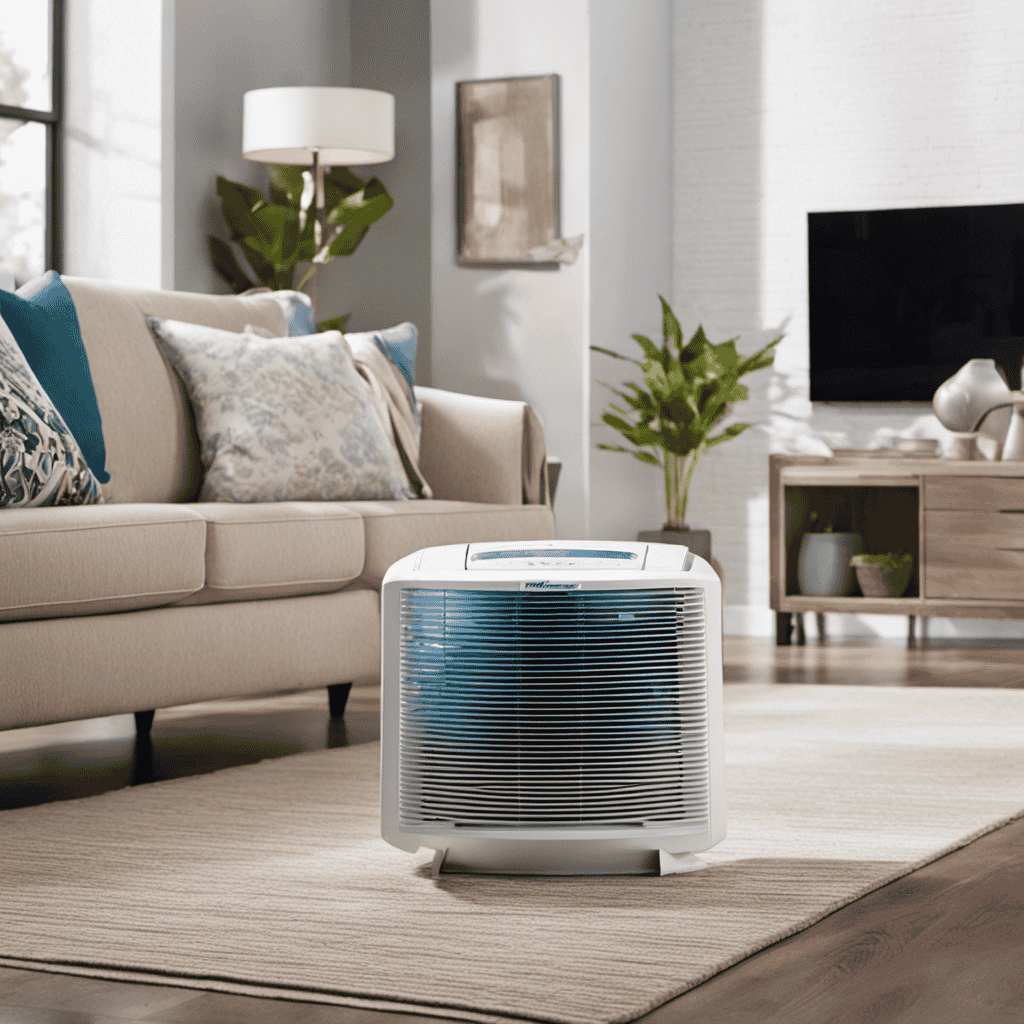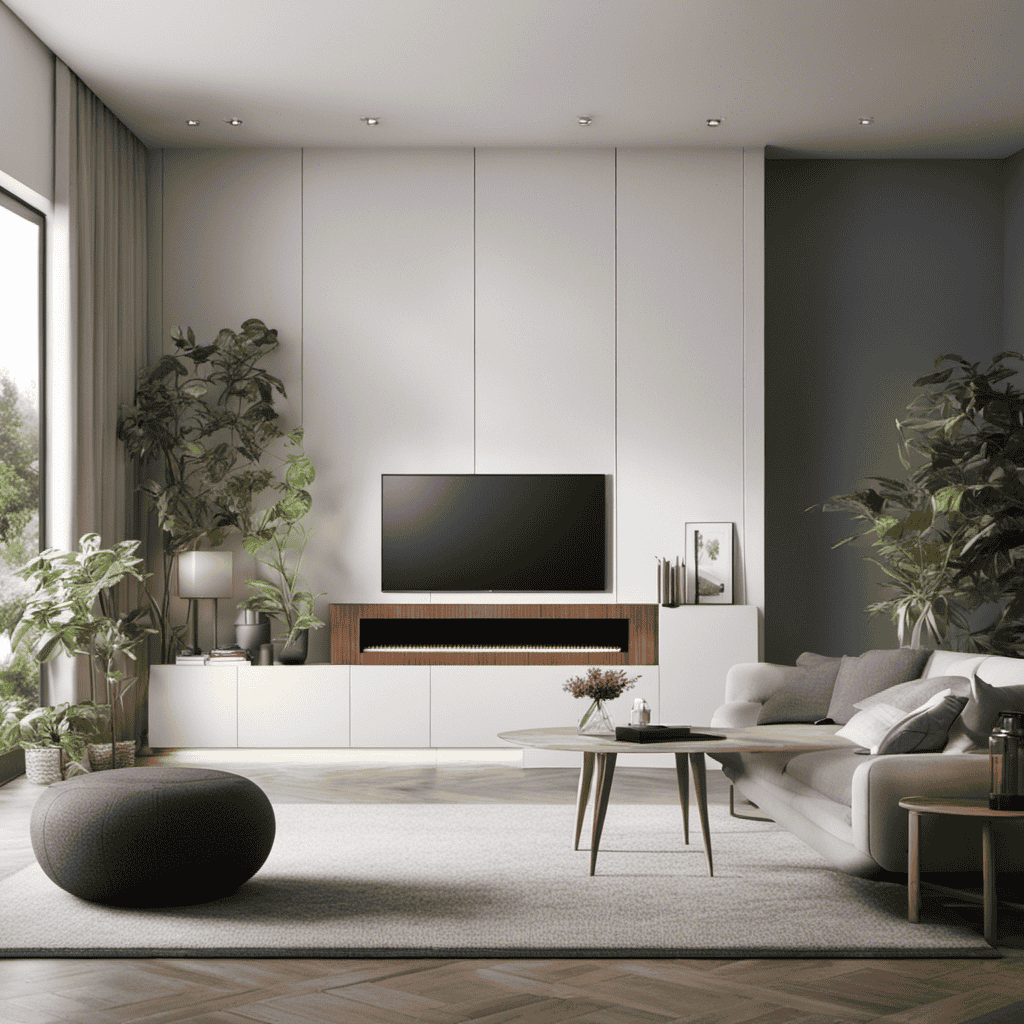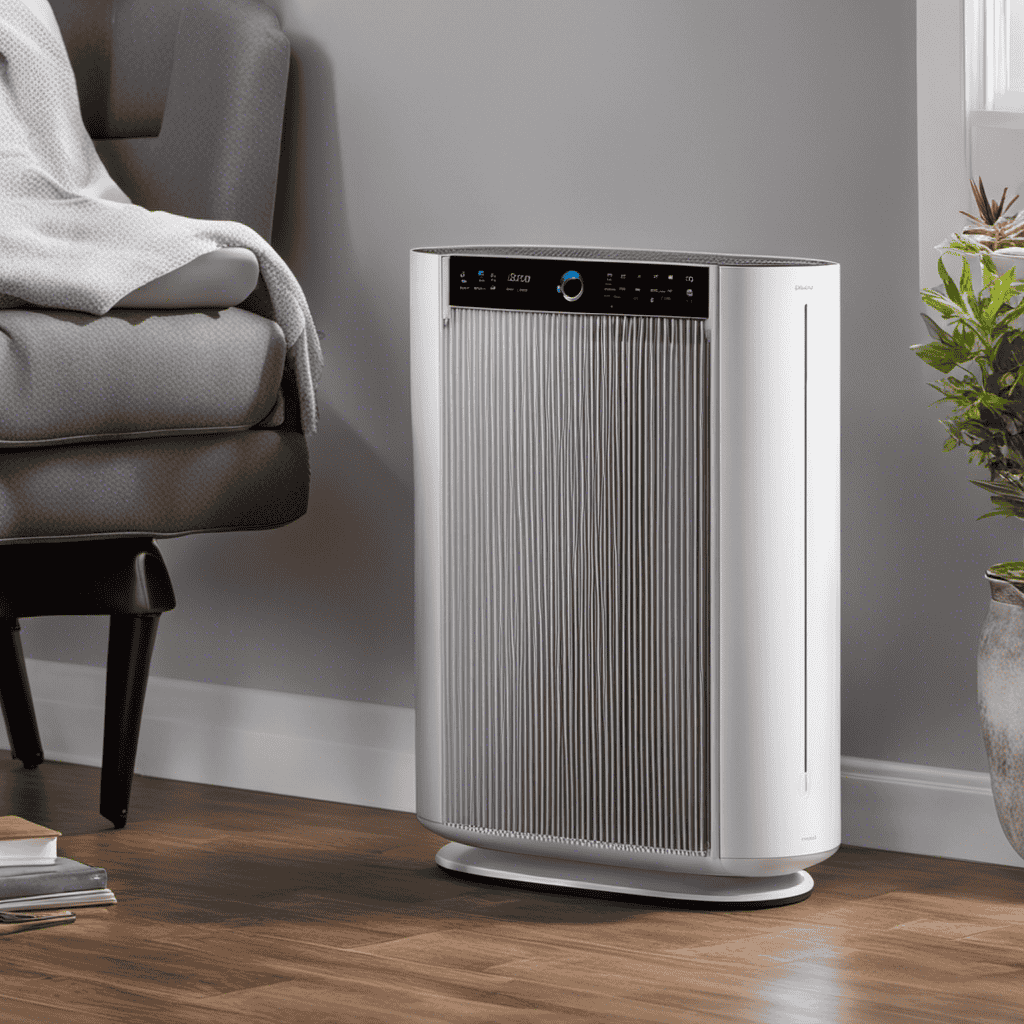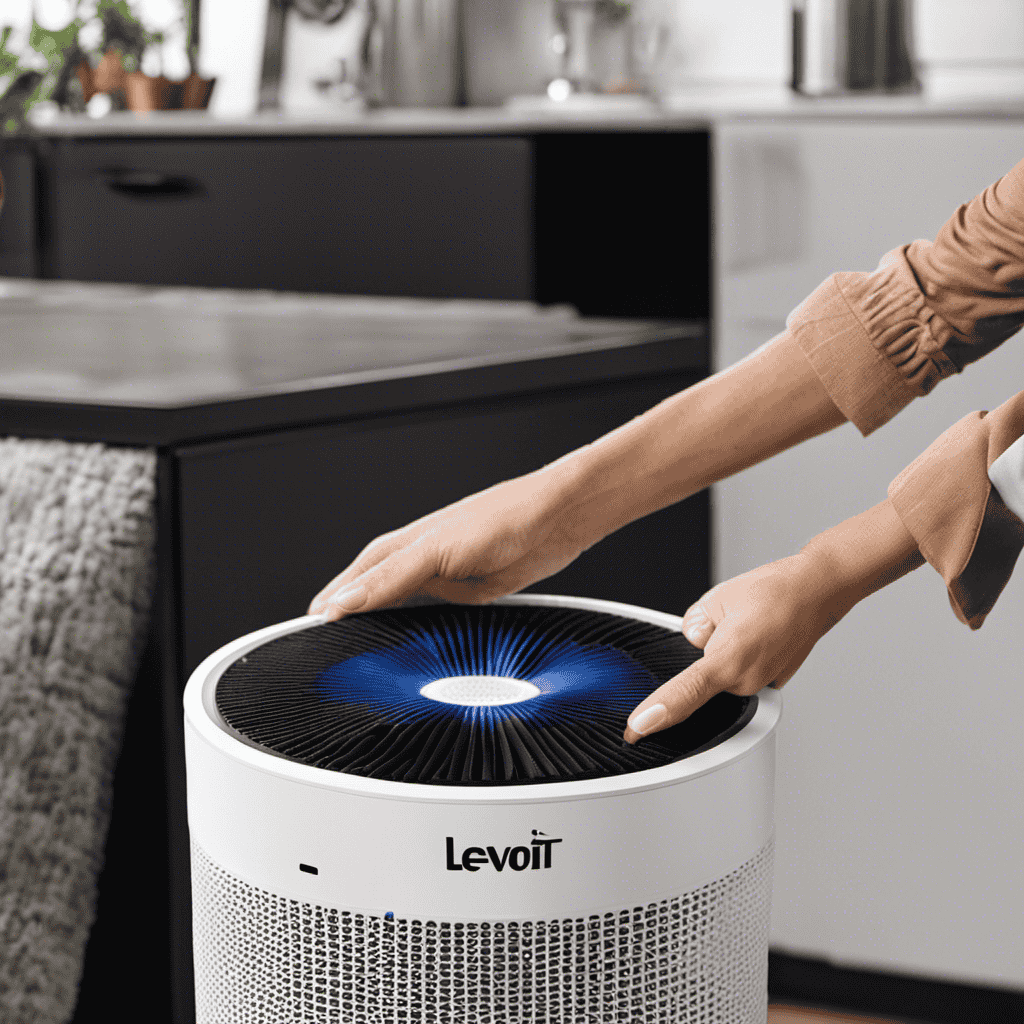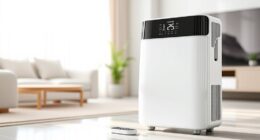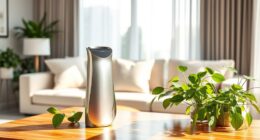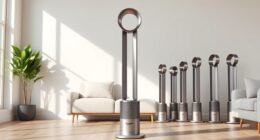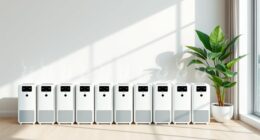I’ve discovered the secret to banishing that foul odor from your air purifier. Trust me, I’ve been there – the frustration of a clean machine that emits a not-so-pleasant scent.
But fear not, because I’m here to share my expert tips on how to get rid of that bad odor once and for all. With a few simple techniques and a little know-how, you’ll be breathing in fresh, clean air in no time.
So, let’s dive in and say goodbye to that unpleasant smell together.
Key Takeaways
- Regular cleaning and maintenance are essential to prevent bad odors in air purifiers.
- Proper ventilation in the room where the air purifier is located is important to reduce moisture and prevent the growth of mold and mildew.
- Natural odor absorbers like essential oils with antibacterial properties and activated charcoal can help neutralize and absorb odors in air purifiers.
- Diluting essential oils with carrier oils and following safety guidelines is important when using them in air purifiers.
Common Causes of Bad Odor in Air Purifiers
One common cause of bad odor in your air purifier is a buildup of mold and mildew. Mold and mildew thrive in damp and dark environments, making your air purifier an ideal breeding ground for them. When left unchecked, these microorganisms can release unpleasant odors into the air.
To prevent this issue, it is crucial to practice proper maintenance techniques. Regularly cleaning and disinfecting your air purifier will help eliminate any mold or mildew growth. Additionally, ensuring adequate ventilation in the room where the air purifier is placed can help reduce moisture levels and discourage the growth of these odor-causing agents.
Proper Cleaning and Maintenance Techniques
To ensure your air purifier remains clean and functions properly, it’s crucial to regularly maintain and clean it according to the manufacturer’s instructions. Following a proper cleaning and maintenance schedule is essential for optimal performance.
One of the cleaning hacks I’ve found useful is to vacuum the exterior of the air purifier regularly to remove dust and debris. Additionally, cleaning the filter is vital to keep it working efficiently. I recommend checking the manufacturer’s guidelines on how often to replace or clean the filter.
Maintaining a consistent cleaning routine will help prevent bad odors from developing in your air purifier.
Now, let’s explore another effective method for eliminating odors: using natural odor absorbers.
Using Natural Odor Absorbers
I’ve found that using natural odor absorbers can be a highly effective way to eliminate unpleasant smells in my air purifier.
One method I’ve used is adding a few drops of essential oils to the air purifier. Essential oils have natural antibacterial and deodorizing properties.
Another option is using activated charcoal. Activated charcoal is known for its ability to absorb odors and toxins.
Lastly, I’ve also tried the baking soda absorption method. I sprinkle baking soda on a plate and place it near the air purifier to neutralize and absorb odors.
Essential Oils as Absorbers
Using essential oils as absorbers will help eliminate the bad odor from your air purifier. Essential oils are a safe and natural option for freshening the air in your home. When using essential oils in your air purifier, it is important to follow proper safety guidelines.
Make sure to dilute the oils with a carrier oil, such as coconut or almond oil, to prevent any irritation or allergic reactions. Additionally, choose oils that are known for their odor-absorbing properties, such as lavender, lemon, or eucalyptus. These oils not only mask the bad odor but also help neutralize it.
There are many DIY air freshener recipes available online that can guide you in creating your own unique blend of essential oils to freshen the air in your home.
Activated Charcoal for Odor
Adding activated charcoal to your air purifier is an effective way to neutralize and eliminate unwanted smells. Activated charcoal has long been recognized for its odor-absorbing properties. It works by trapping odor molecules within its porous surface, preventing them from circulating in the air.
One of the key benefits of using activated charcoal is its ability to remove a wide range of odors, including those caused by pets, cooking, and smoke. Unlike other odor absorbers, activated charcoal does not release any fragrances or chemicals into the air, making it a safe and natural alternative.
In addition to its odor-neutralizing capabilities, activated charcoal also helps to purify the air by removing impurities and toxins. However, if you are looking for an alternative odor absorber, there are other options available such as baking soda.
Baking Soda Absorption Method
To effectively remove unwanted smells, try the baking soda absorption method in your air purifier. This method is one of the most effective odor elimination methods available.
Baking soda has the ability to absorb and neutralize odors, making it an ideal choice for freshening the air in your home. Simply place a small bowl of baking soda near your air purifier or sprinkle some directly onto the air filter.
As the air passes through the purifier, the baking soda will absorb any unpleasant smells, leaving your air clean and fresh. Unlike alternative air fresheners that simply mask odors, baking soda actually eliminates them at the source.
It’s a simple and cost-effective solution for maintaining a fresh and odor-free environment in your home.
Removing Mold and Mildew From Air Purifiers
It’s important to regularly clean your air purifier to prevent mold and mildew buildup. Maintaining a clean air purifier is crucial when it comes to removing dust particles and preventing allergies. Mold and mildew can thrive in the moist environment inside the purifier, leading to potential health issues.
To effectively remove mold and mildew, start by unplugging the purifier and removing the filters. Use a soft cloth or brush to gently wipe away any visible mold or mildew. Next, mix a solution of equal parts water and vinegar and use it to clean the filters and the interior of the purifier. Allow the parts to air dry completely before reassembling the purifier.
Regularly cleaning your air purifier will not only remove mold and mildew but also ensure optimal performance in removing dust particles and preventing allergies.
Dealing With Pet Odors in Air Purifiers
When you have pets, you’ll want to regularly clean your air purifier to address any lingering pet odors. Pet odors can be particularly stubborn and unpleasant, so it’s important to take the necessary steps to keep your air purifier fresh and odor-free.
Here are some tips to help you deal with pet odors in your air purifier:
-
Vacuum regularly: Pet hair can accumulate in the air purifier and contribute to unpleasant odors. Make sure to vacuum your air purifier regularly to remove any trapped pet hair.
-
Change filters frequently: Pet dander and allergens can get trapped in the filters of your air purifier. To prevent the spread of pet allergies, it’s important to change the filters frequently to maintain optimal air quality.
Eliminating Smoke Odor From Air Purifiers
Eliminating smoke odor from air purifiers can be challenging, but there are effective strategies you can try. As someone who has dealt with this issue firsthand, I understand the frustration of having a lingering smell in your home. When it comes to removing cigarette smell or eliminating cooking odor from your air purifier, there are a few key steps to follow. First, make sure to clean the filters regularly to prevent the odor from becoming trapped. Secondly, consider using activated carbon filters, as they are highly effective in absorbing and neutralizing odors. Lastly, keep your air purifier in a well-ventilated area to ensure proper circulation. By following these strategies, you can effectively eliminate smoke odor from your air purifier and enjoy fresh, clean air in your home.
| Steps to Eliminate Smoke Odor |
|---|
| Clean filters regularly |
| Use activated carbon filters |
| Keep air purifier in well-ventilated area |
Addressing Chemical Odors in Air Purifiers
When it comes to addressing chemical odors in air purifiers, there are several effective solutions available.
One option is to use specialized filters or carbon-based filters designed specifically to remove chemical odors from the air.
Another solution is to utilize air purifiers with activated carbon technology, which can effectively trap and neutralize chemical odors.
Lastly, to prevent future odors, it is important to regularly clean and maintain the air purifier, replace filters as recommended, and ensure proper ventilation in the area.
Chemical Odor Solutions
To get rid of the chemical odor in your air purifier, you can try using activated charcoal or baking soda. These DIY odor solutions are effective and readily available.
Here are two options to consider:
-
Activated charcoal: This is a highly porous substance that can absorb and neutralize odors in your air purifier. Simply place a few activated charcoal briquettes or sachets inside the purifier, and let them work their magic. Remember to replace or recharge the charcoal regularly for continued odor removal.
-
Baking soda: Another popular and affordable option is baking soda. Its natural deodorizing properties can help eliminate chemical odors from your air purifier. Just sprinkle some baking soda on a plate or inside a container and leave it near the purifier. Replace the baking soda every few weeks to maintain its effectiveness.
By using these DIY odor solutions, you can effectively remove chemical odors from your air purifier and enjoy fresh, clean air in your space.
Now, let’s explore the features of an effective air purifier.
Effective Air Purifier
If you want cleaner and fresher indoor air, consider investing in an air purifier with effective features. An effective air purifier is crucial in removing pollutants, allergens, and odor-causing particles from the air.
When it comes to choosing the best air purifier brands, there are a few key factors to consider. Look for brands that have a strong reputation for producing high-quality products and are known for their advanced technology and filtration systems. Some of the top air purifier brands include Dyson, Honeywell, and Coway.
These brands offer a range of models that cater to different needs and room sizes. Additionally, consider features such as HEPA filtration, activated carbon filters, and smart functionality for optimal performance and convenience.
Investing in an effective air purifier from a reputable brand ensures that you can breathe easier and enjoy cleaner indoor air.
Preventing Future Odors
Investing in an effective air purifier with activated carbon filters can help prevent future odors from lingering in your home. When it comes to air purifier maintenance and odor prevention techniques, there are a few key strategies to keep in mind:
-
Regular filter replacement: Activated carbon filters are designed to absorb and trap odors, but they can become saturated over time. It’s important to follow the manufacturer’s recommendations for filter replacement to ensure optimal odor control.
-
Proper placement: Where you place your air purifier can make a big difference in its effectiveness. Position it in areas where odors are most prevalent, such as near pet areas or in the kitchen.
-
Routine cleaning: In addition to filter replacement, regular cleaning of your air purifier is crucial. Dust and debris can accumulate on the unit, hindering its ability to remove odors effectively.
Troubleshooting Tips for Persistent Odors
You can try cleaning the filters and replacing any activated carbon to tackle persistent odors in your air purifier.
When it comes to troubleshooting, there are a few common mistakes that people often make.
One mistake is neglecting to clean the filters regularly. Over time, the filters can become clogged with dirt, dust, and other particles, which can lead to unpleasant odors.
Another common mistake is forgetting to replace the activated carbon. This substance is responsible for absorbing odors, but it has a limited lifespan. If you don’t replace it when necessary, the air purifier won’t be as effective in eliminating bad smells.
Lastly, some people overlook the importance of cleaning the entire unit, including the fan and vents. Dust and debris can accumulate in these areas, contributing to the odor problem.
Preventing Future Odor Build-up in Air Purifiers
To prevent future odor build-up in your air purifiers, it’s important to regularly clean the filters and replace the activated carbon. By doing so, you can ensure that your air purifier continues to function optimally and effectively eliminate unpleasant odors from your home.
Here are some key steps to maintain your air purifier’s performance:
-
Cleaning the filters:
-
Remove the filters from the unit and gently vacuum or rinse them to remove any dust or debris.
-
Allow the filters to dry completely before placing them back into the air purifier.
-
Replacing the activated carbon:
-
Activated carbon plays a crucial role in absorbing and neutralizing odors.
-
Check the manufacturer’s instructions to determine the recommended frequency for replacing the activated carbon.
Frequently Asked Questions
Can I Use Scented Air Fresheners to Mask the Bad Odor in My Air Purifier?
Using scented air fresheners in an air purifier may temporarily mask the bad odor, but it won’t effectively remove it. To truly eliminate the smell, consider cleaning the filters, using activated charcoal, or seeking professional assistance.
How Often Should I Clean My Air Purifier to Prevent Bad Odors?
To maintain the effectiveness of my air purifier, I need to know how often to replace the filters. Additionally, understanding common causes of bad odors in air purifiers will help me prevent them in the future.
Can I Use Vinegar as a Natural Odor Absorber for My Air Purifier?
Yes, vinegar can be used as a natural odor absorber for my air purifier. However, baking soda is a more effective alternative. Bad odor can significantly impact the performance of an air purifier.
How Do I Know if There Is Mold or Mildew in My Air Purifier?
To determine if there’s mold or mildew in an air purifier, inspect the filter and interior for any signs of growth or moisture. Regular maintenance is crucial to prevent these common causes of bad odor in air purifiers.
Are There Any Specific Air Purifier Models That Are More Effective in Eliminating Pet Odors?
In my experience, the most effective air purifier models for eliminating pet odors are those that are specifically designed to target allergens and smoke. They have proven to be highly efficient in removing bad odors.
Conclusion
In conclusion, maintaining an odor-free air purifier is essential for a fresh and clean environment. By following proper cleaning techniques and using natural odor absorbers, you can eliminate common causes of bad odor.
Remember, like a diligent gardener tending to their plants, regular maintenance and troubleshooting are key to preventing future odor build-up. So, don’t let your air purifier become a breeding ground for unpleasant smells.
Take control and enjoy the crisp, scent-free air that your purifier provides.

